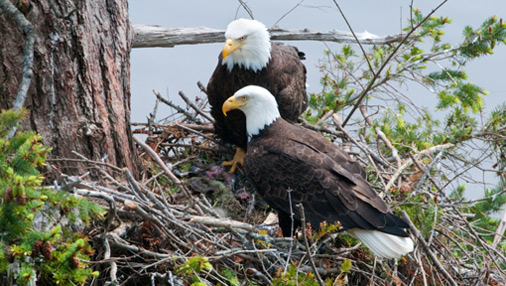You’ve got to feel for the poor peregrine falcons in Pittsburgh. They were all the sensation when they began nesting in Pittsburgh in 1991, but recently, they’ve been shunted from the limelight by the return of bald eagles to the Pittsburgh area. The Audubon Society is excited to announce that, in addition to the Hays Bald Eagle Nest WebCam that’s been running the past few years, they have added a NEW camera for first-time viewing of the Harmar nest.

The National Audubon Society estimates that bald eagles have not nested in the area for more than 250 years. The eagles have not only returned to the area, but they’ve returned in a big way with three nesting pairs along each of Pittsburgh’s three rivers. One nest is located on the Monongahela River in the community of Hays, the second in Harmarville on the Allegheny River, and the third is in an undisclosed location along the Ohio River. All three nests are located within Allegheny County..
Eagles need mature tall trees in which to nest and plenty of fish on which to feed. Sadly, in the 18th century, the large trees lining our rivers were cut down to be used as lumber and fuel for the expanding city. Later in the 19th century, industrialization led to water pollution and depletion of the fish in our rivers. Contributing to the decline of bald eagles was the use of the pesticide DDT, which was found to thin the eggshells of our national symbol.
Endangered Species
As a result, the bald eagle was placed on the federal Endangered Species list. In 1972, DDT was banned and the Clean Water Act was passed by Congress, but not before Pennsylvania’s nesting pairs had dwindled to a few by the mid-1980s. The Pennsylvania Game Commission, which oversees the protection of our native birds, intervened by bringing healthy nesting pairs to the state from the thriving population of bald eagles in Saskatchewan. The efforts to save the bald eagle in our area have become encouraging. By 2000, there were an estimated 50 known nesting pairs in the state, and in 2012 that population grew to 200 nesting pairs. And now they are back in the ‘Burgh!
The eagles have not only built nests here, they have also made a home in our hearts. It is estimated that 3 million webcam views were logged by PixController, which has trained a lens on the birds and their eaglets in the Hays and Harmar nests. The bald eagles have their own Facebook page, and many folks have lined the Three Rivers Heritage Trail to spy through binoculars at the majestic birds as if they were Hollywood stars.
Not only is this a cause for celebration for the bald eagles, but for our environment and other birds as well. Recently, the Game Commission released that the osprey population is also increasing, and in the near future, may be removed from the state’s threatened list. Also known for nesting near water and preying on fish, ospreys were so sparse in the area that they had to be reintroduced in the state between 1980 and 1996. If the bald eagle, osprey, and peregrine falcon are back, you know the area must also be habitable for other species that were threatened as well.
Two eggs were laid during the 2015 season in the Hays nest, but sadly, neither egg was viable. Watching the live-streaming webcams is always a fantastic way to learn more about the the bald eagles inhabiting the Pittsburgh area.
To view the Pittsburgh Hays Bald Eagle Nest WebCam, which was re-installed for the 2016 season, and the Harmar Bald Eagle Nest WebCam hosted by the Audubon Society and PixController, visit: www.pixcontroller.com/eagles/.
The post Bald Eagles: The Birds Are Back in the ‘Burgh appeared first on Popular Pittsburgh.